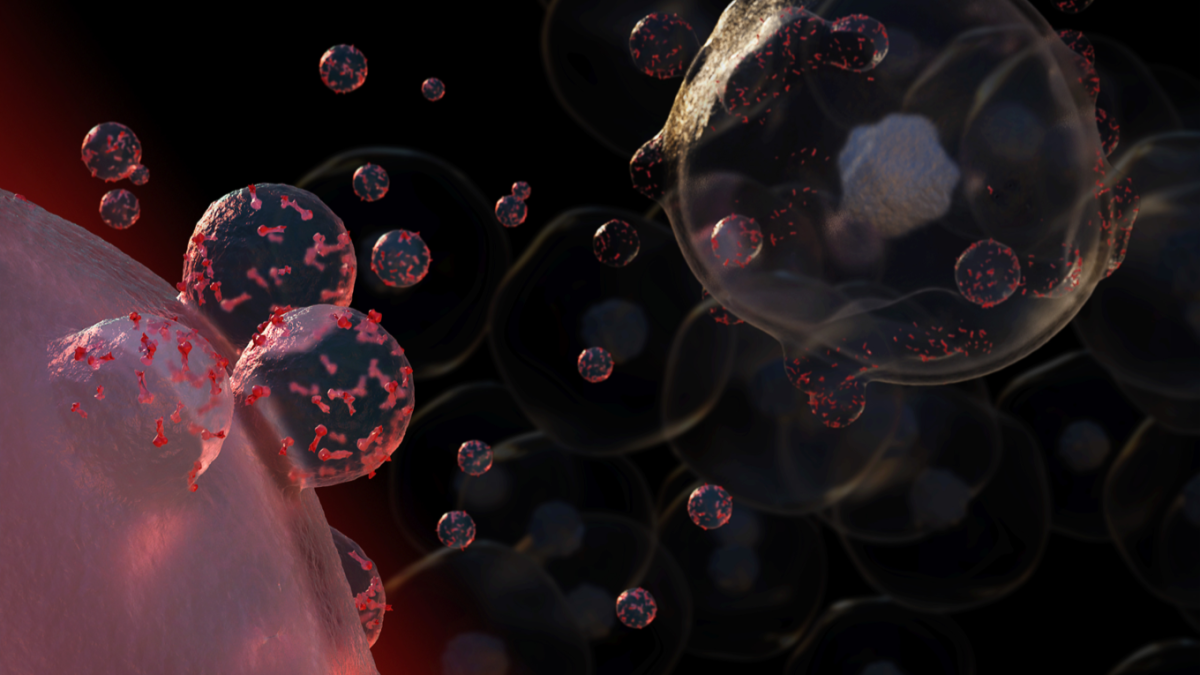Researchers offer new strategies for the use of extracellular vesicles as biomarkers

Extracellular vesicles are lipid-bound particles containing nucleic acids or proteins that are naturally secreted from cells. Serving a variety of functions ranging from activation of the immune system to disposing of intracellular waste, these vesicles circulate the body continuously, and their contents shed light on potential diseases, including various types of cancer. Graphic by Jason Drees
With advances in technology and our understanding of the human body come better techniques for diagnosing disease. One recent innovation involves the use of extracellular vesicles as biomarkers for a range of illnesses. Extracellular vesicles are tiny bubbles of material emitted from most living cells that can offer vital clues about the status of the cells producing them.
However, the field of extracellular vesicle (EV) research is a relatively new one, and there are more refinements to be made to translate EV-based diagnostic tools into a clinical setting.
Arizona State University Biodesign researchers Tony Hu, Jia Fan and Bo Ning wrote a review paper, published in the Royal Society of Chemistry, outlining challenges in developing EV diagnostic tools and potential strategies to ameliorate these, all in the context of diagnosing cancer.
Fan and Hu are professors in the Biodesign Virginia G. Piper Center for Personalized Diagnostics, and Ning is a professor in the Biodesign Center for Molecular Design and Biomimetics.
Much of this review paper explores the transition of this research from a theoretical framework to viable technologies ready for use and compatible with human samples.
“Previous reviews focus on EV cancer biomarker identification or isolation but lack translational value,” Hu said. “We aim to address the application of EVs as cancer biomarkers and recent progress in EV isolation and analysis methods, and we also discuss the challenges and recommendations for translating potential EV biomarkers for clinical disease diagnostics.”
Extracellular vesicles are lipid-bound particles containing nucleic acids or proteins that are naturally secreted from cells. Serving a variety of functions ranging from activation of the immune system to disposing of intracellular waste, these vesicles circulate the body continuously, and their contents shed light on potential diseases, including various types of cancer.
“Extracellular vesicles contain DNA, RNA and protein cargoes that reflect the status of their parent cells at the time of their formation, making them ideal for biomarker study,” Hu said.
These vesicles are of particular interest in diagnostics because they are found in high concentration and remain stable in easy-to-acquire human samples.
“EVs produced by diseased and healthy cells are secreted into most body fluids, including blood,” Hu said. “The unique composition, long in vivo half-life and physical durability of EVs make them qualified materials to serve as stable and sensitive biomarkers for cancer.”
Although EV research is rapidly evolving, the sheer volume of vesicles circulating the human body makes it challenging to detect disease-associated EVs. This warrants the use of technology that can sort, with high specificity, which vesicles’ contents are characteristic of diseases and which originate from healthy cells.
“Due to the volume and size of EVs, only a limited number of biomarkers are packaged in or on these vesicles,” Hu said. “Thus, a lower limit of detection will significantly improve the application of EV biomarkers.”
Determining how to characterize which proteins or DNA in the vesicles originate from a diseased cell also poses prominent challenges.
“Reliable cancer-derived EV biomarkers are critical for all these approaches. Which marker is specific for cancer but not normal tissue?” Hu said.
But what makes these vesicles a more promising approach for diagnostics than traditional practices, particularly in the context of cancer?
“One of the advantages of EV biomarker analysis is a noninvasive approach, so cancer types which are difficult for traditional biopsy to detect will benefit from this detection, such as pancreatic cancer,” Hu added.
The review paper puts these points into context by listing different biomarkers identified by various studies and the assays used in them. Assays are tools designed to measure the presence and quantity of a specified substance, which in this case would be EVs. The paper deconstructs these studies, listing their pitfalls, what makes them effective and how they can be improved.
Although this paper uses data accumulated from past studies, Hu’s lab also works extensively on developing EV biomarkers and characterization tools.
Their group developed an assay, the nanoplasmon enhanced scattering (nPES) assay, that quantifies the total number of EVs as well as number of EVs that originated from diseased cells. The lab utilized this assay to study EVs in the plasma samples of patients with chronic pancreatitis.
With this technology, they had great success in diagnosing pancreatic cancer, which is a testament to their state-of-the-art EV biomarker technology as well as the efficacy of such technology to provide diagnoses with higher specificity.
“We found that nPES signals distinguished healthy patients from patients with chronic pancreatitis, and the results corresponded with tumor burden, stage and early response to therapy.”
More Science and technology

Turning up the light: Plants, semiconductors and fuel production
What can plants and semiconductors teach us about fuel production?ASU's Gary Moore hopes to find out.With the aim of learning how…

ASU technical innovation enables more reliable and less expensive electricity
Growing demand for electricity is pushing the energy sector to innovate faster and deploy more resources to keep the lights on…

What do a spacecraft, a skeleton and an asteroid have in common? This ASU professor
NASA’s Lucy spacecraft will probe an asteroid as it flys by it on Sunday — one with a connection to the mission name.The asteroid…

